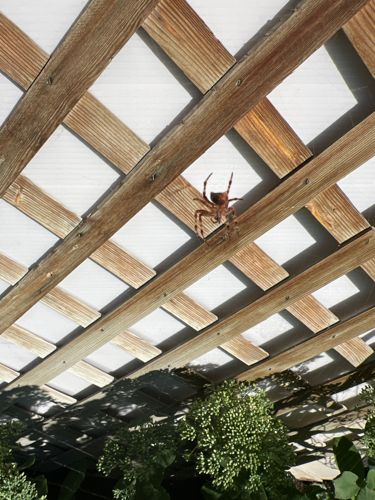Orb Weaver Spider (likely an Argiope or Neoscona species from the image, but specific identification is difficult without more detail)
Scientific Name: Various genera within Araneidae (e.g., Argiope, Neoscona, Araneus), exact species not identifiable from image.
Order & Family: Order: Araneae (Spiders), Family: Araneidae (Orb Weavers)
Size: Body length typically ranges from 5 mm to 30 mm (0.2 to 1.2 inches), with females often being significantly larger than males. Leg span can be much larger.

Natural Habitat
Orb weavers can be found in a wide variety of habitats, including gardens, forests, fields, across streams, and near human structures like houses, fences, and pergolas (as seen in the image). They prefer areas where they can easily stretch their webs between anchor points.
Diet & Feeding
Mainly insects, such as flies, moths, mosquitoes, beetles, and sometimes other small invertebrates, which they catch in their sticky webs.
Behavior Patterns
Orb weavers are known for building large, intricate, and beautiful spiral wheel-shaped webs, often across pathways, between trees, or on structures. They are typically nocturnal, building or repairing their webs at dusk and resting during the day, often hidden nearby or within a retreat on the web. They are generally solitary creatures.
Risks & Benefits
Risks: Orb weaver spiders are generally not dangerous to humans. Their venom is potent to insects but usually causes only mild local pain, redness, or swelling if they bite a human, similar to a bee sting. They are not aggressive and will only bite if provoked or accidental pressure is applied. Benefits: They are highly beneficial to ecosystems and for pest control, as they capture and consume a large number of nuisance insects, helping to maintain ecological balance.
Identified on: 8/23/2025